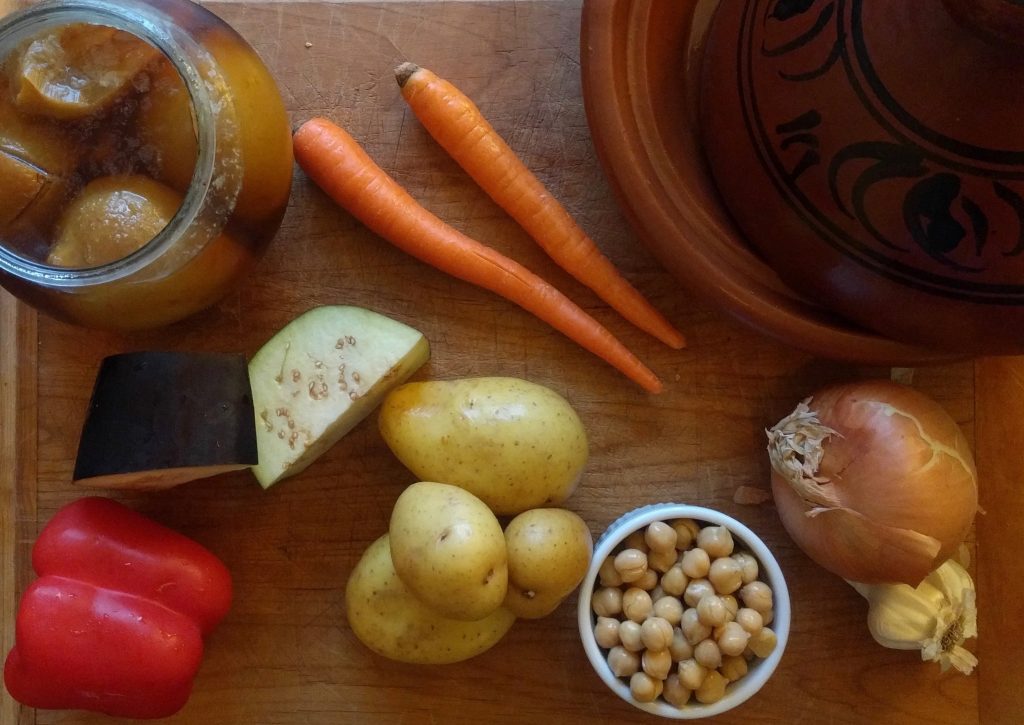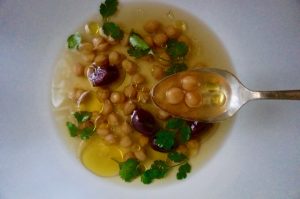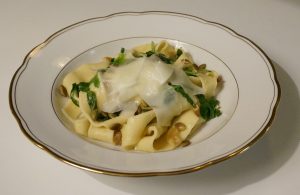
I love hearty kinds of food, like stews and soups. Some years back, I discovered preserved lemons and that lead to an obsession with cooking in tagines that lasted for a while. If you haven’t had preserved lemons yet, I can only say that time is of the essence. Once you’ve had them, you’ll be cursing yourself for wasting precious time when you could have partaken of their sour, salty goodness. Preserved lemons are nothing but lemons that have been stuck in a very salty brine for some months. The main goal of this preservation is making the lemon rind edible (and it’s delicious), but I use the entire fruit. You can use preserved lemons in pretty much any savory dish that calls for lemons. I’ve used them in pesto and stuffings and soups, but my favorite place for them is in the tagine.
A tagine is a conical cooking pot that works similar to a dutch oven. You can use them on the stovetop or in the oven, or both. Either way produces delicious slow-cooked stews. I bought a tagine after moving to the states, but unfortunately I didn’t take the instructions seriously (I have to buy a heat diffuser? What is this nonsense!), and now it has a large crack in the base. I still use it, but to prevent any liquid from dripping onto and into the heating elements on the stove, I now have to cover the base with tin foil before use. Now you’re probably thinking ‘and let that be a lesson for you to read the instructions!’, but the truth is that I forget about this inconvenience between uses. Obviously, every time I get out my tagine to cook in it, I am reintroduced to the consequences of my actions, and while I’m struggling with the tin foil I ask myself if it might be time to buy a new tagine and throw this useless one away. But before I can come to a conclusion, the foil is in place, I’m in the middle of chopping vegetables, and any brain space for practical thoughts of tagine replacement is usurped by questions of how to spice the dish this time. And now it’s three years later and I still have a broken tagine. Which, by the way, still produces delicious stews like the one I made yesterday.
I start by heating the tagine base very slowly (although the crack in the base suggests that I haven’t always done this, or at least not slowly enough). Then I add oil and onion and let them melt for a bit. When they are getting transparent I add things like potato, carrot, and garlic. When everything has browned a little, I add the softer veggies like peppers and eggplant, as well as spices like cinnamon, sumac, thyme, chili, coriander, and cumin. And importantly, preserved lemon. Since the lemons are very salty, it’s a good idea to wait to add more salt until everything has cooked for a while and you can taste what the end result will be like. So at this point, I put the lid on the tagine and then I leave it to cook for one or two hours, checking every 20 minutes and adding a bit of water if it seems dry.
By this time, the smell of the stew will have diffused the entire house. But this will still be nothing compared to the amazing aroma that will greet you when you lift off the lid to begin serving. And when you’re enjoying tender vegetables coated in spice and lemon, you’ll wonder why you don’t use your tagine more often, and you’ll have repressed every thought of broken cookware. It’s that good.






